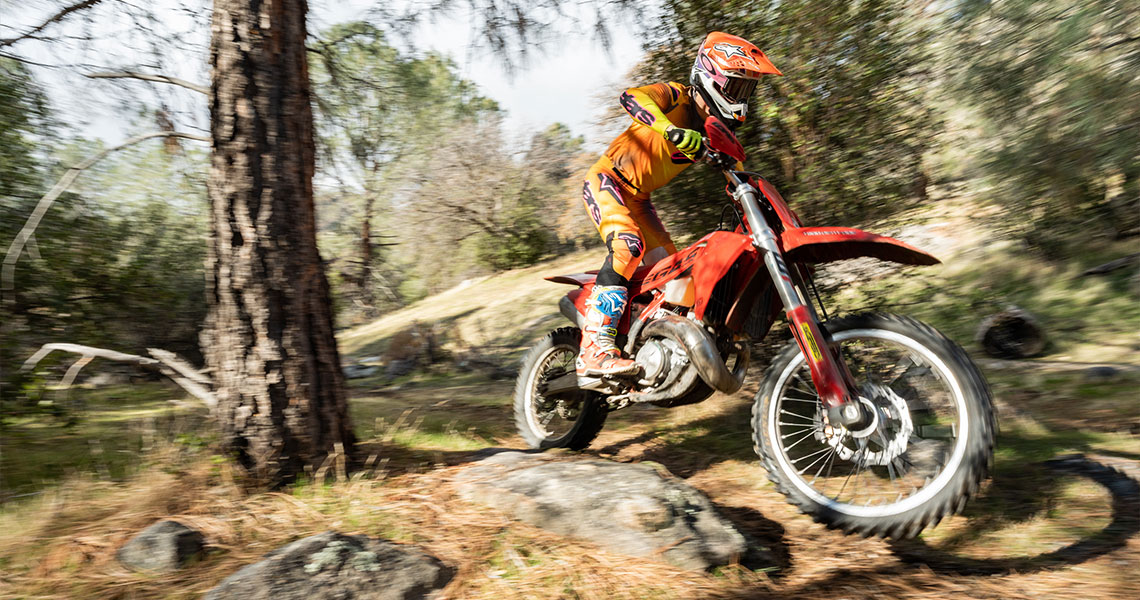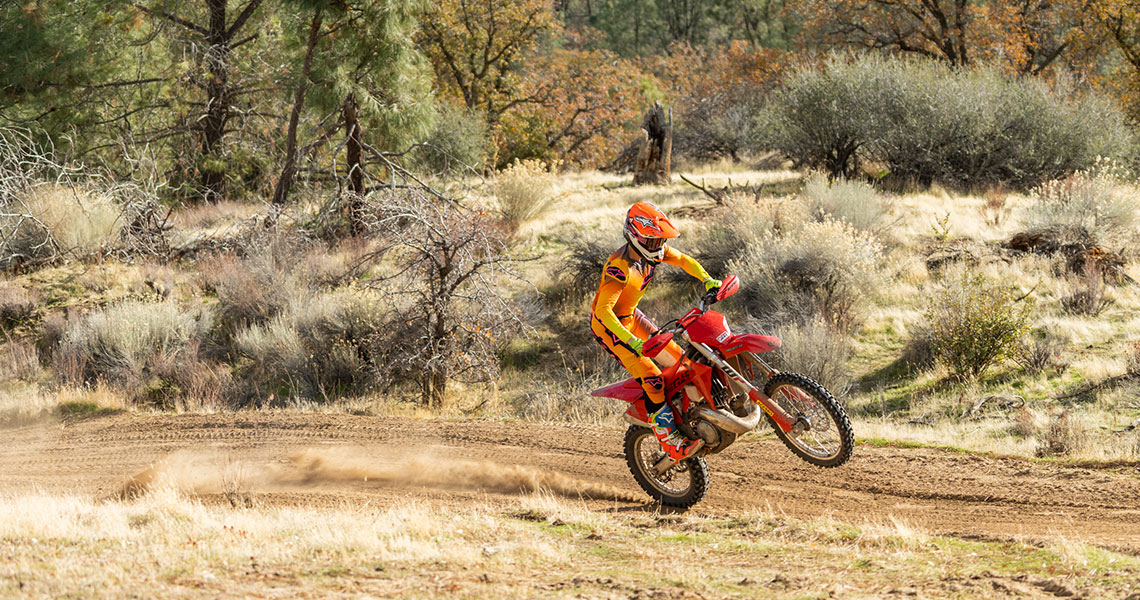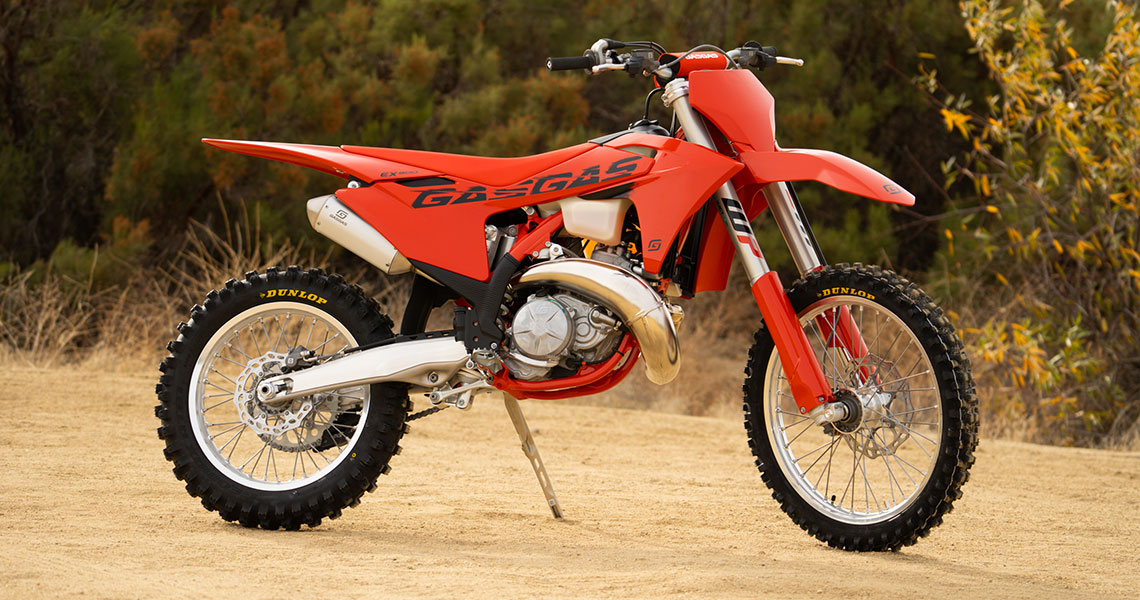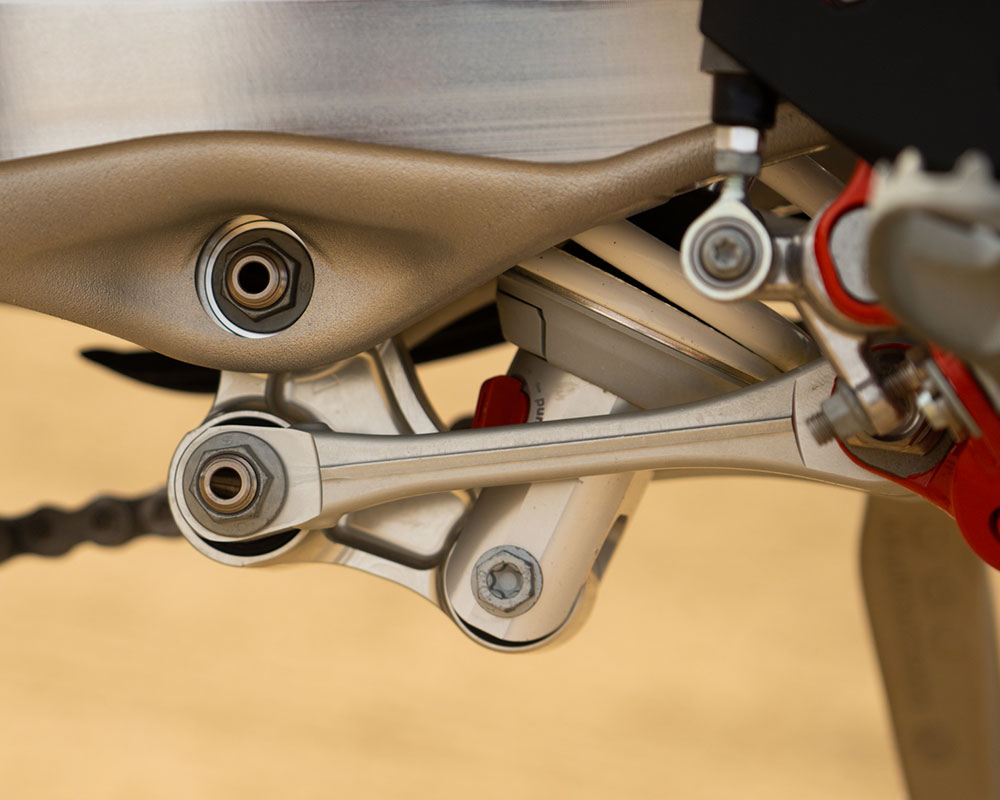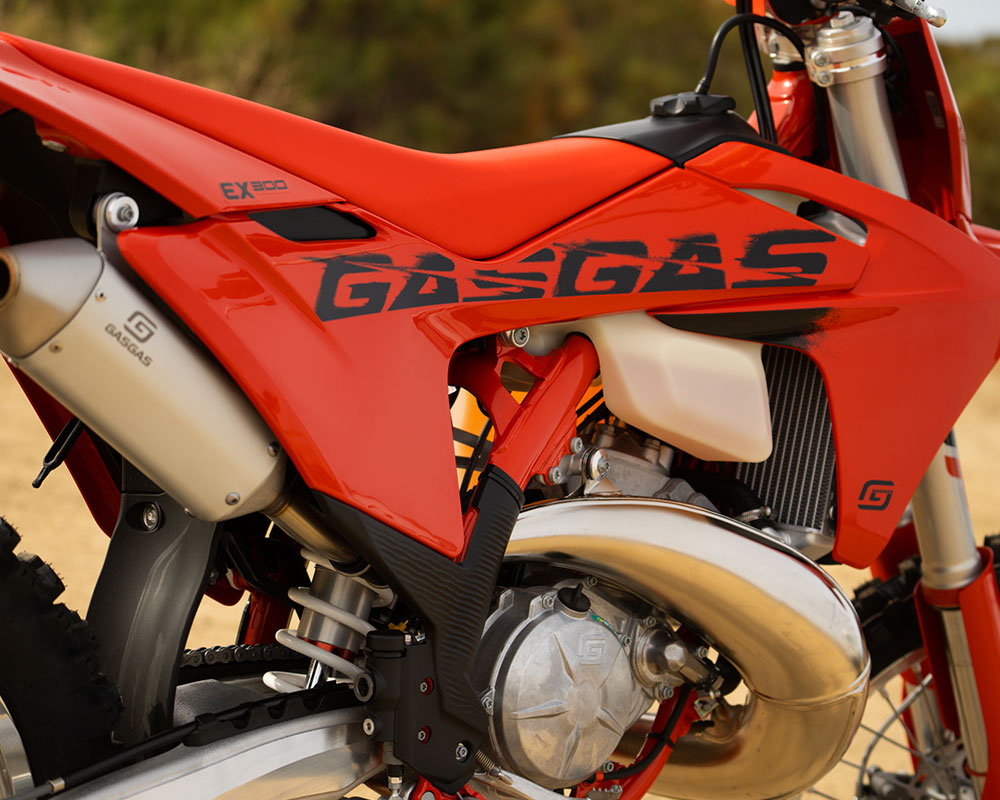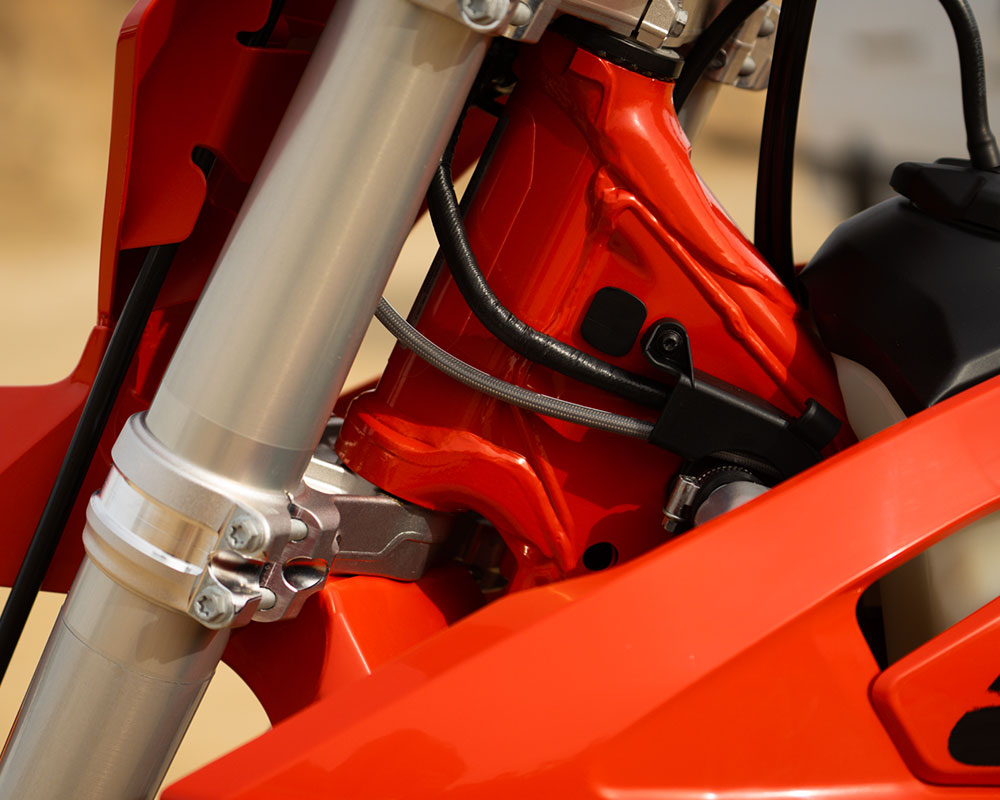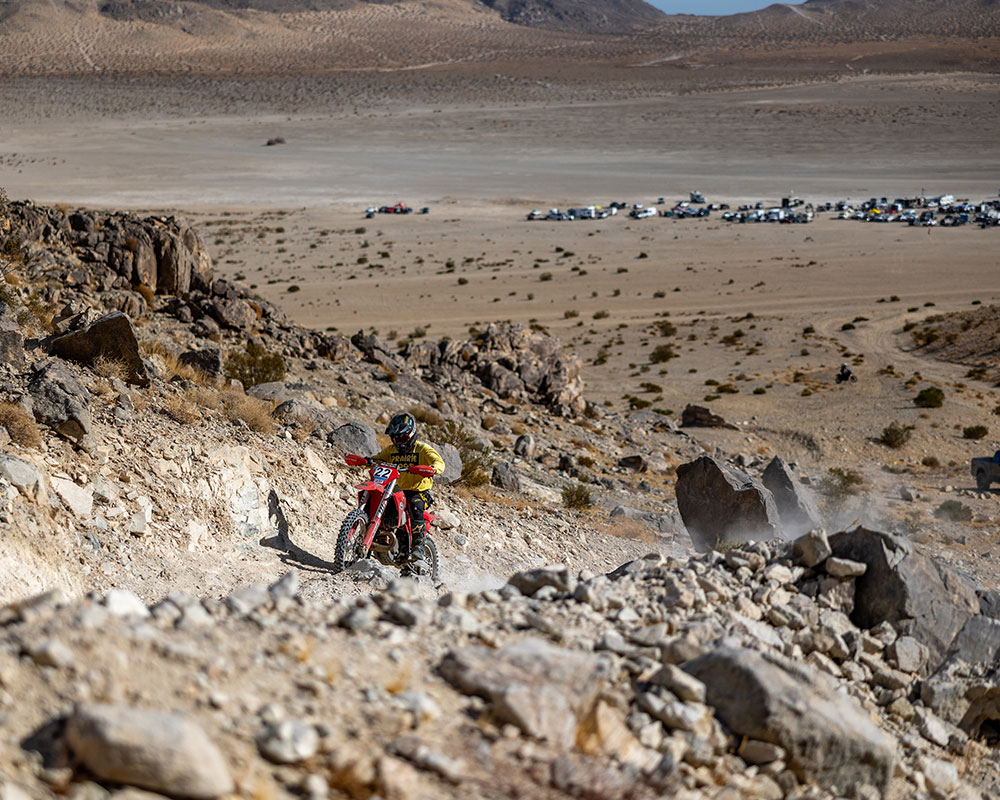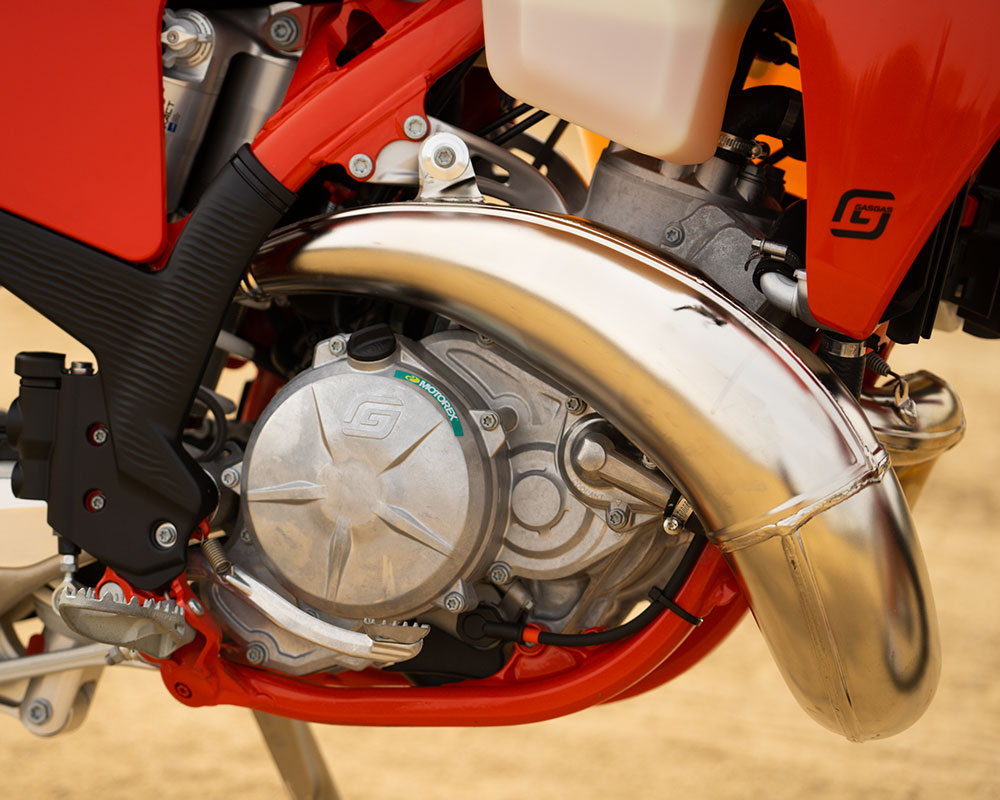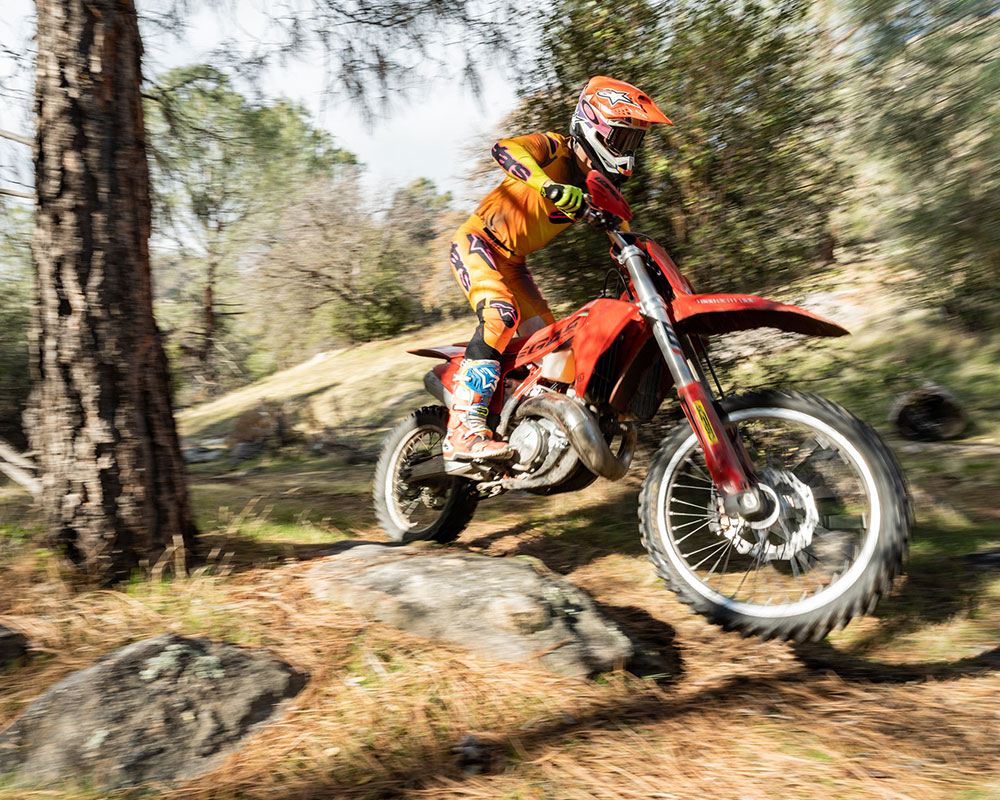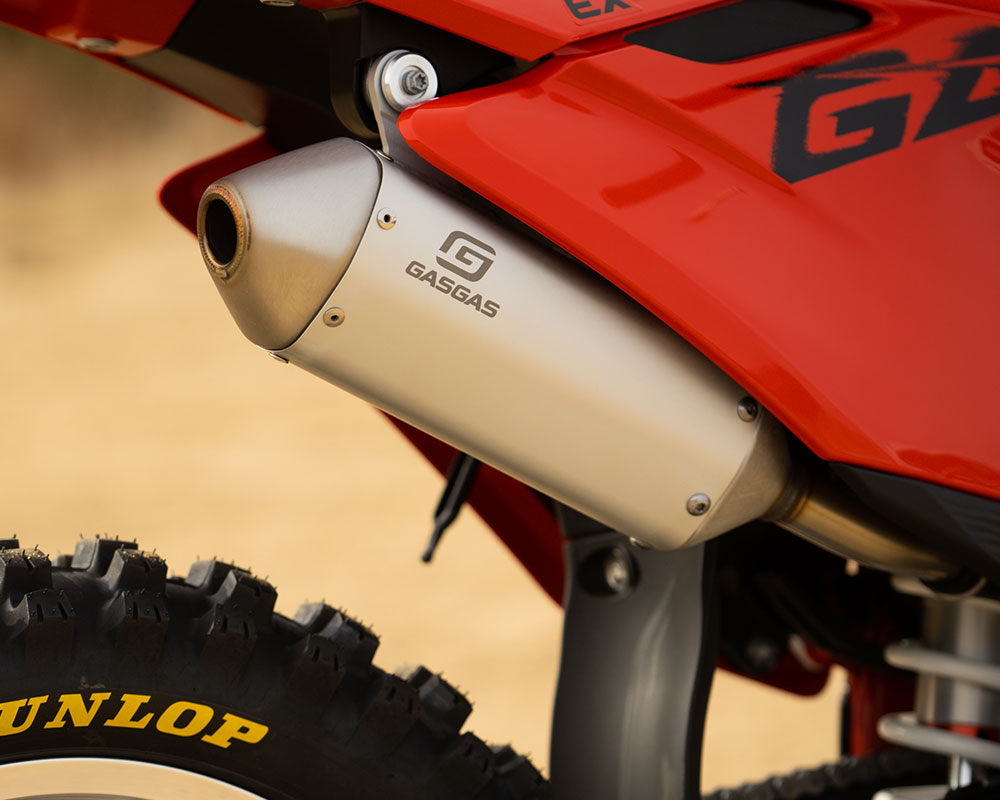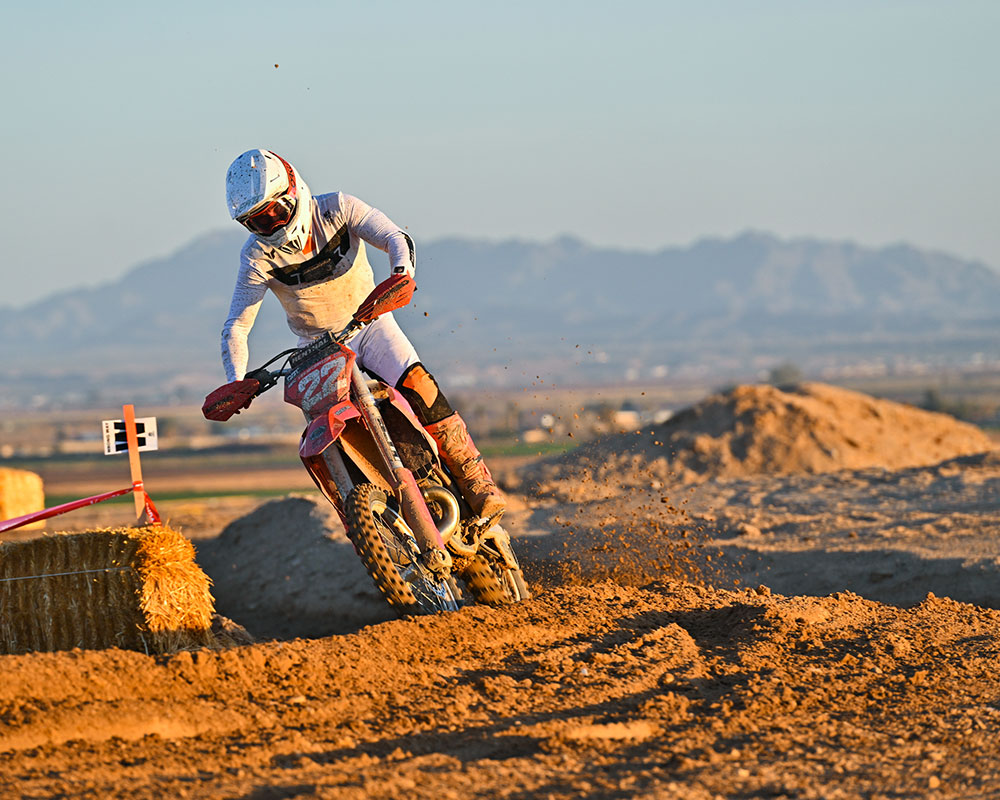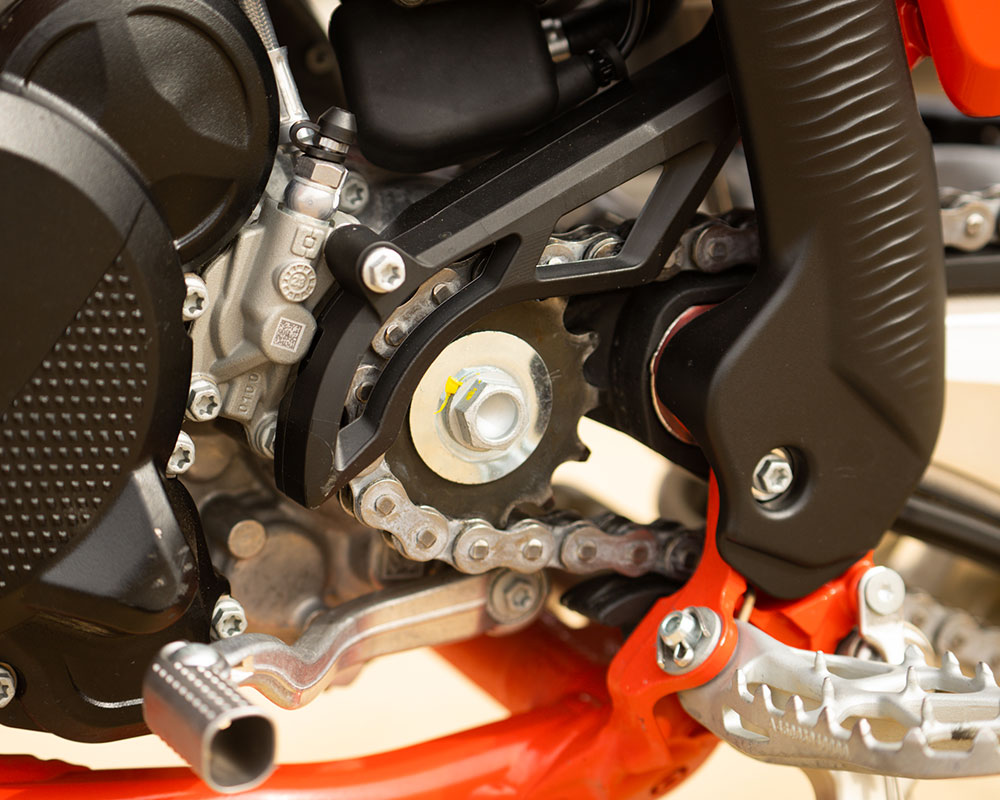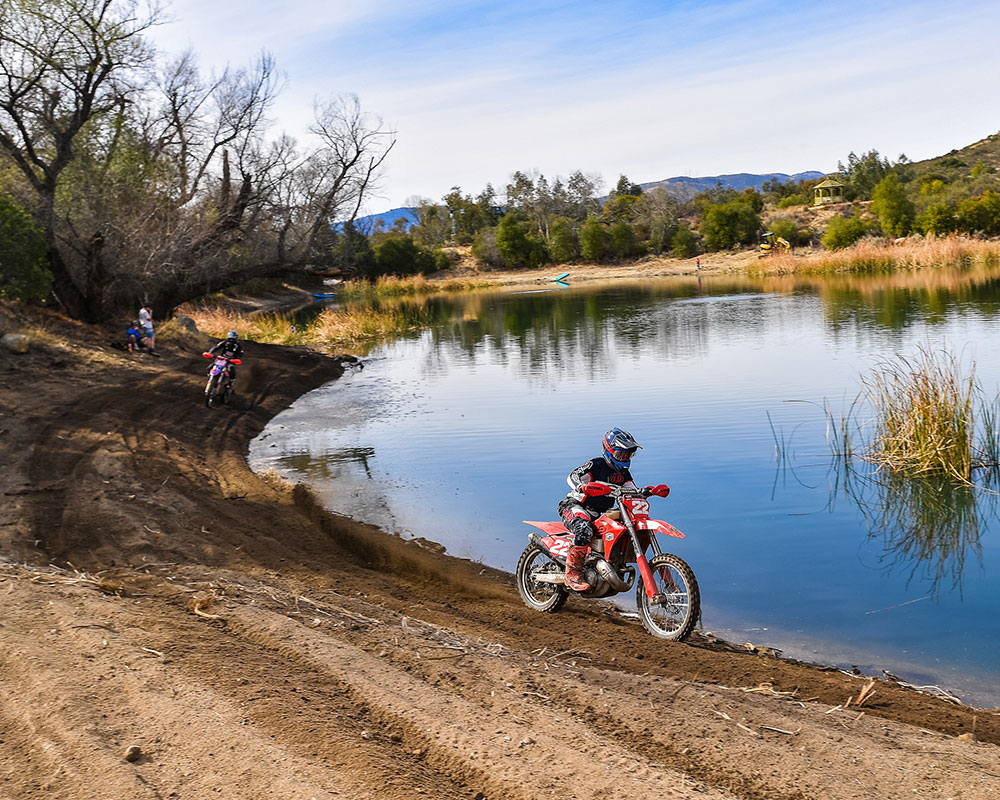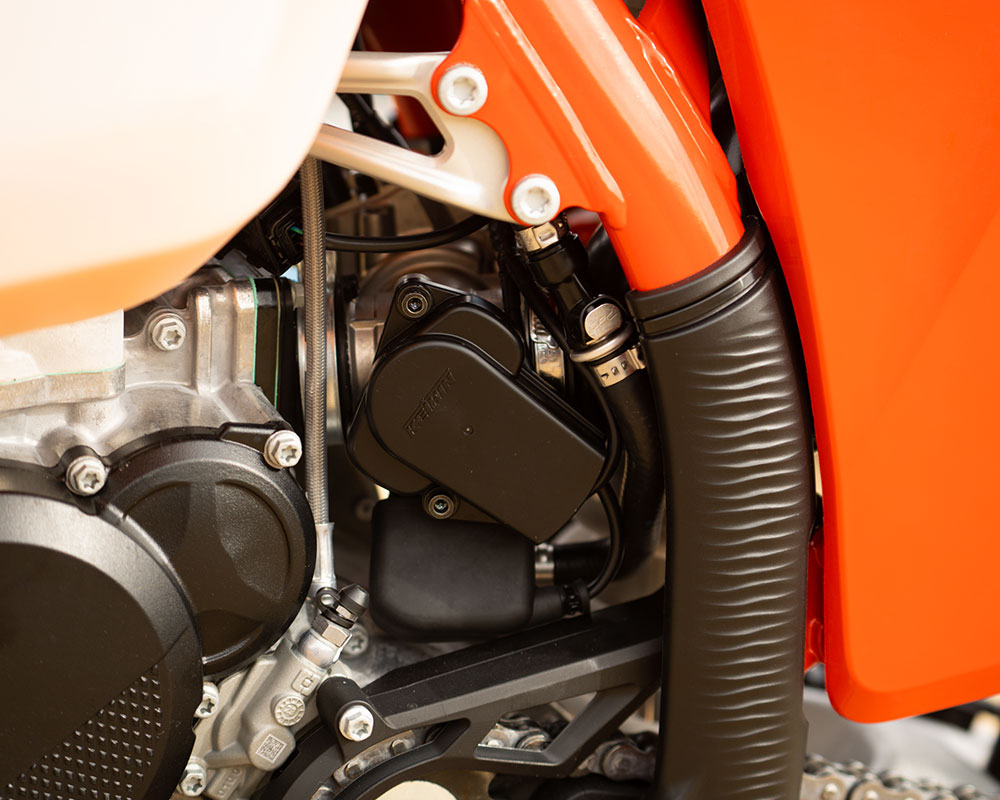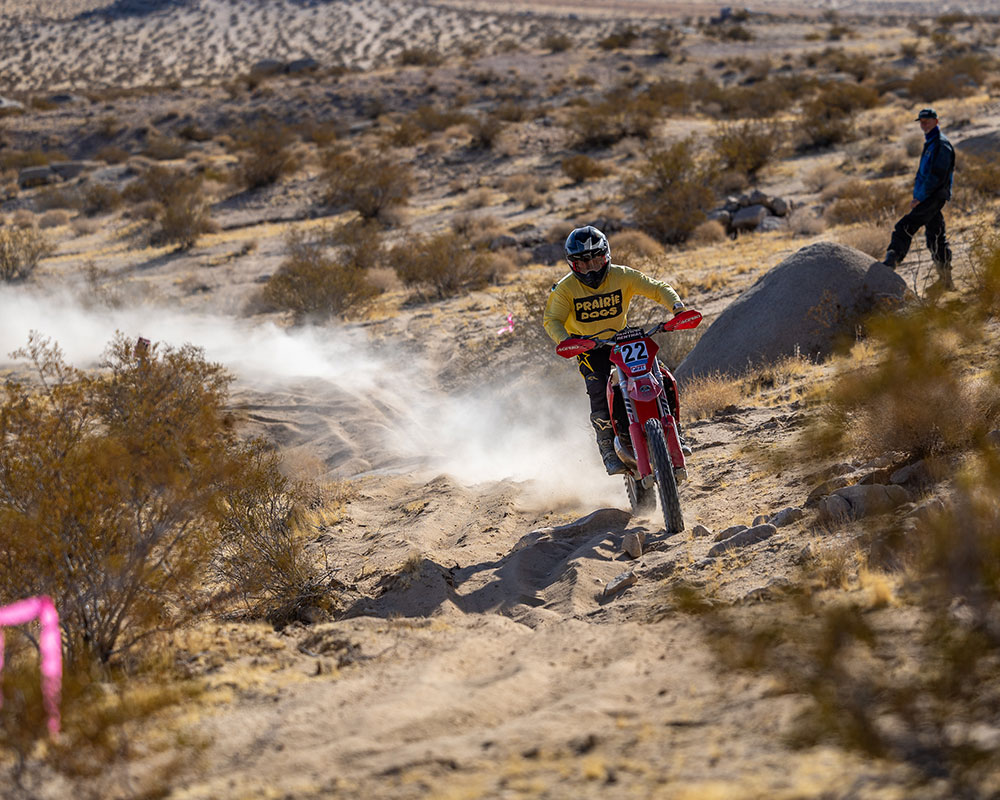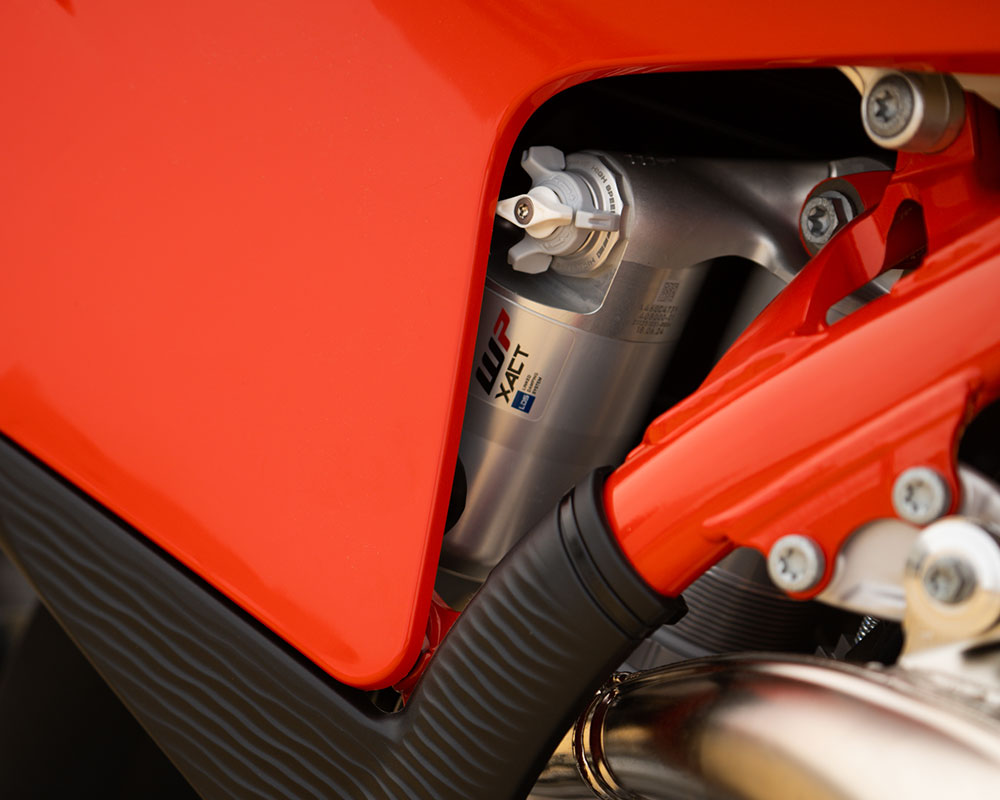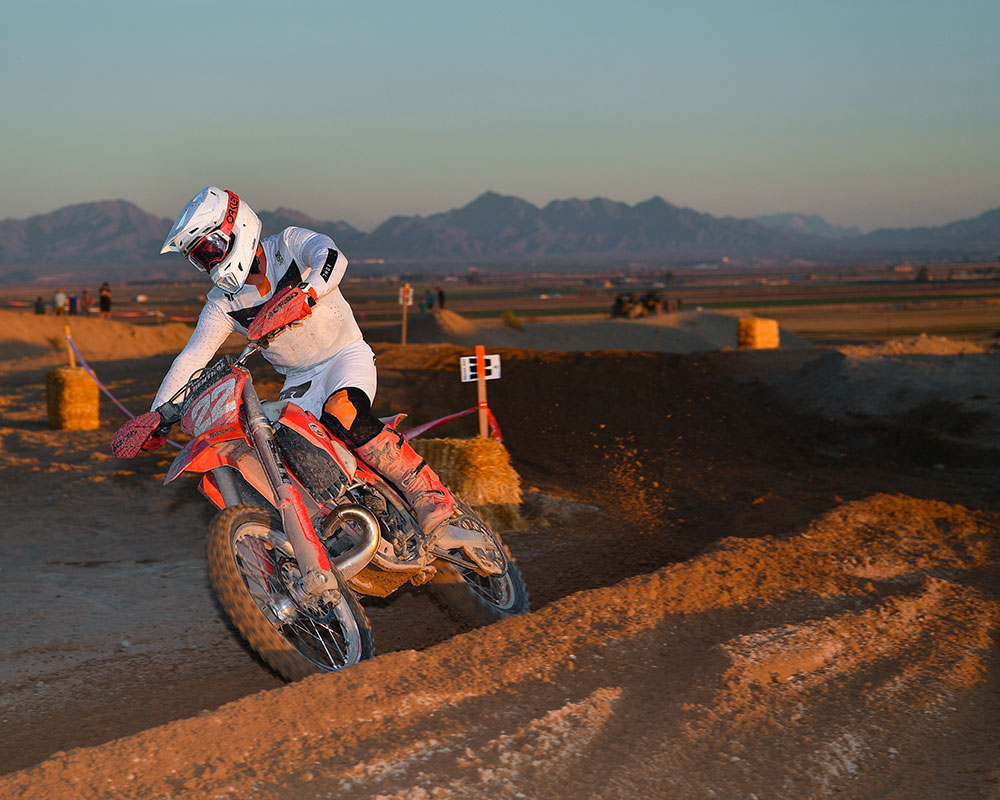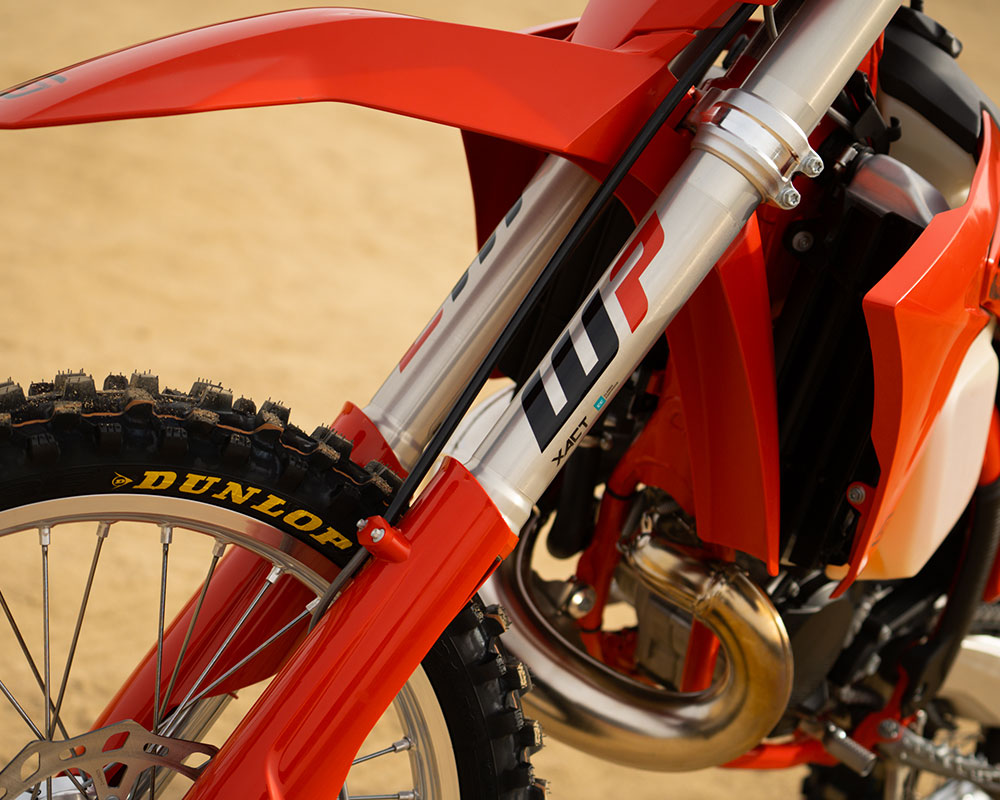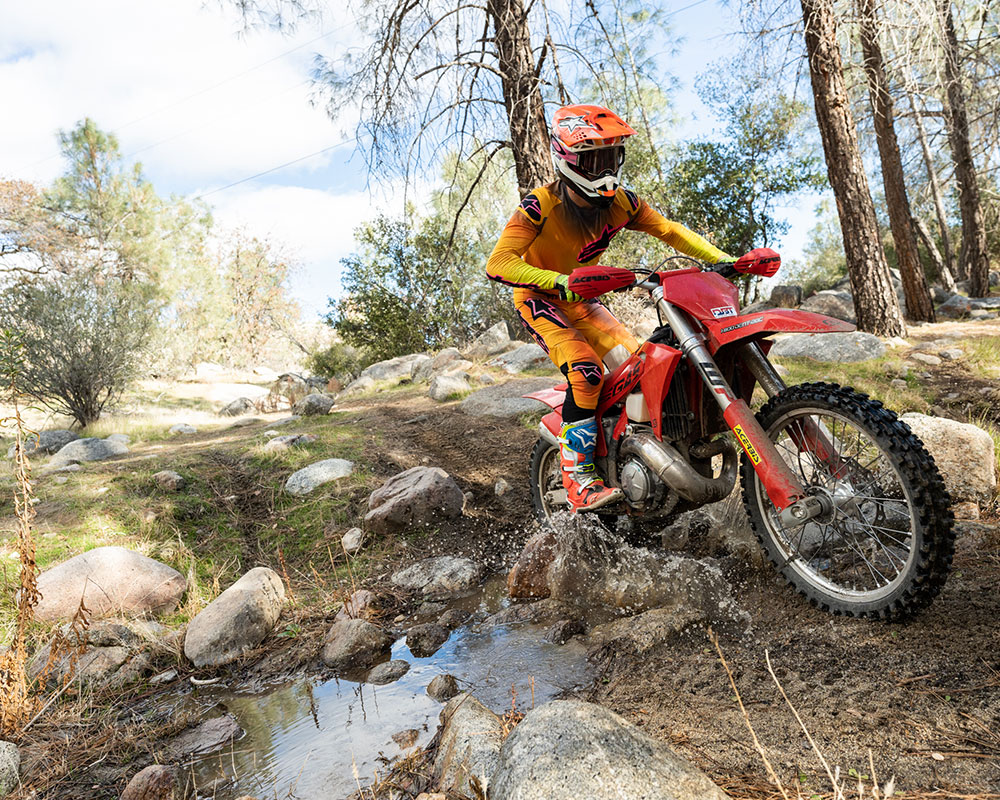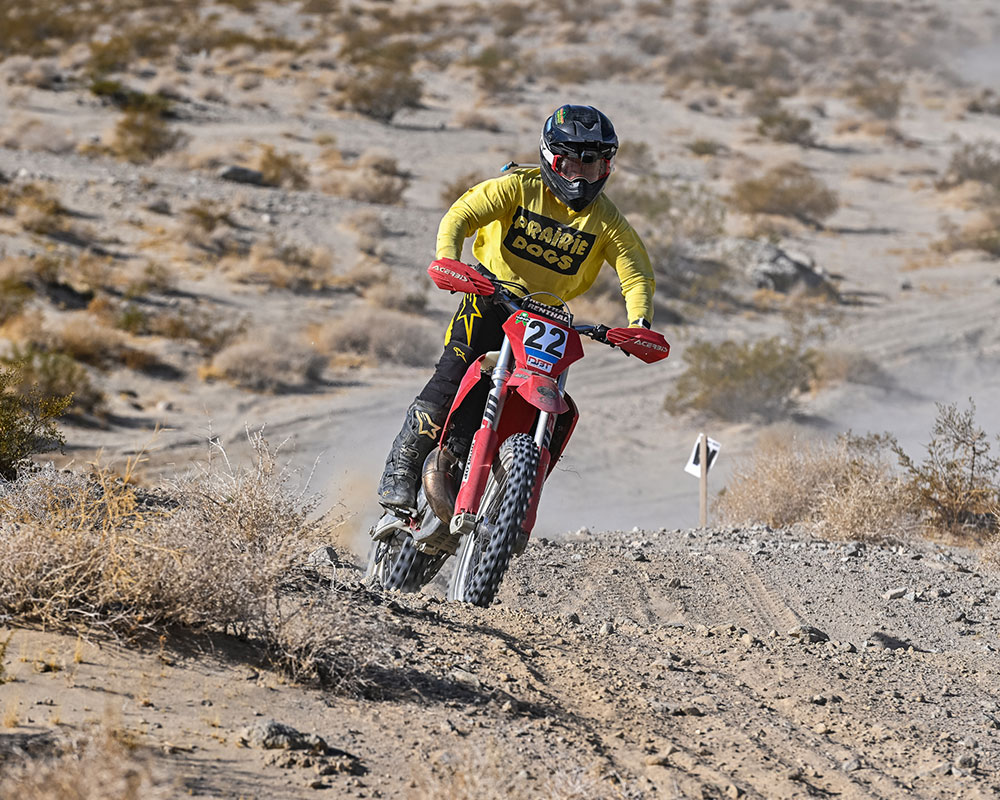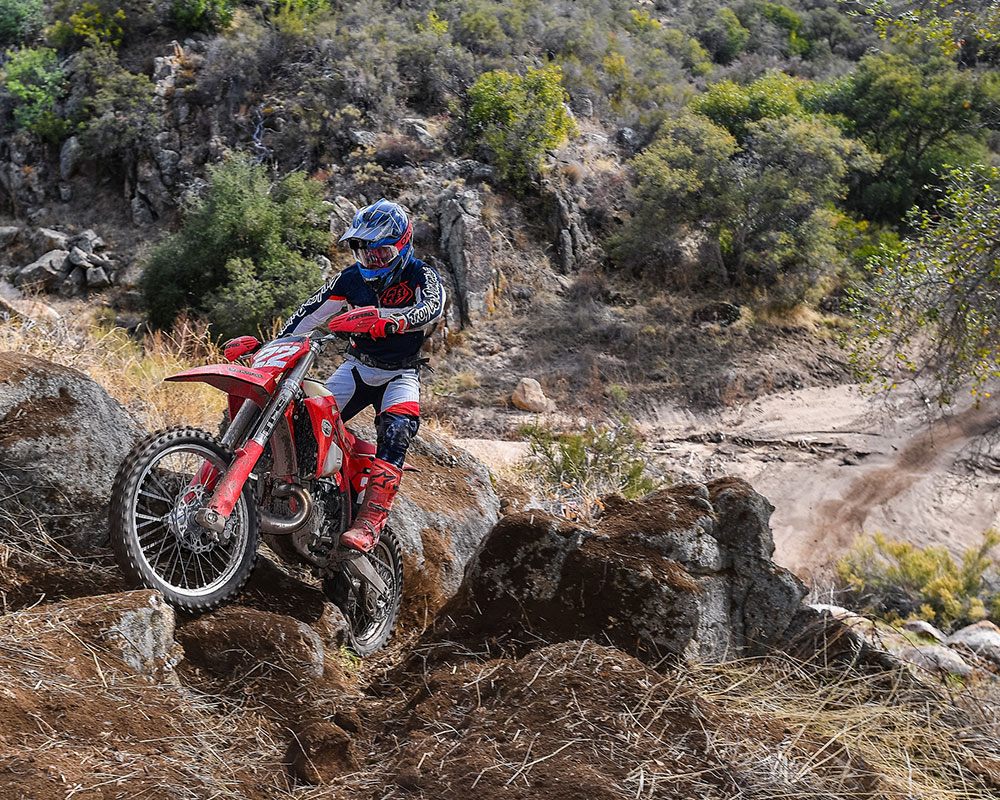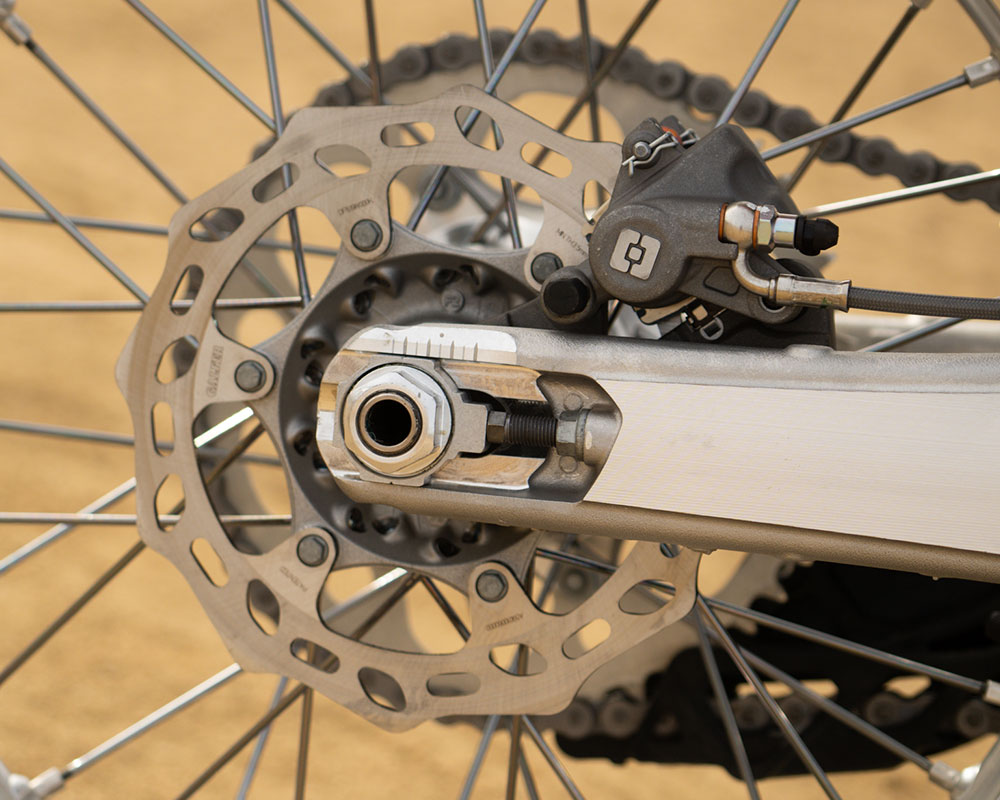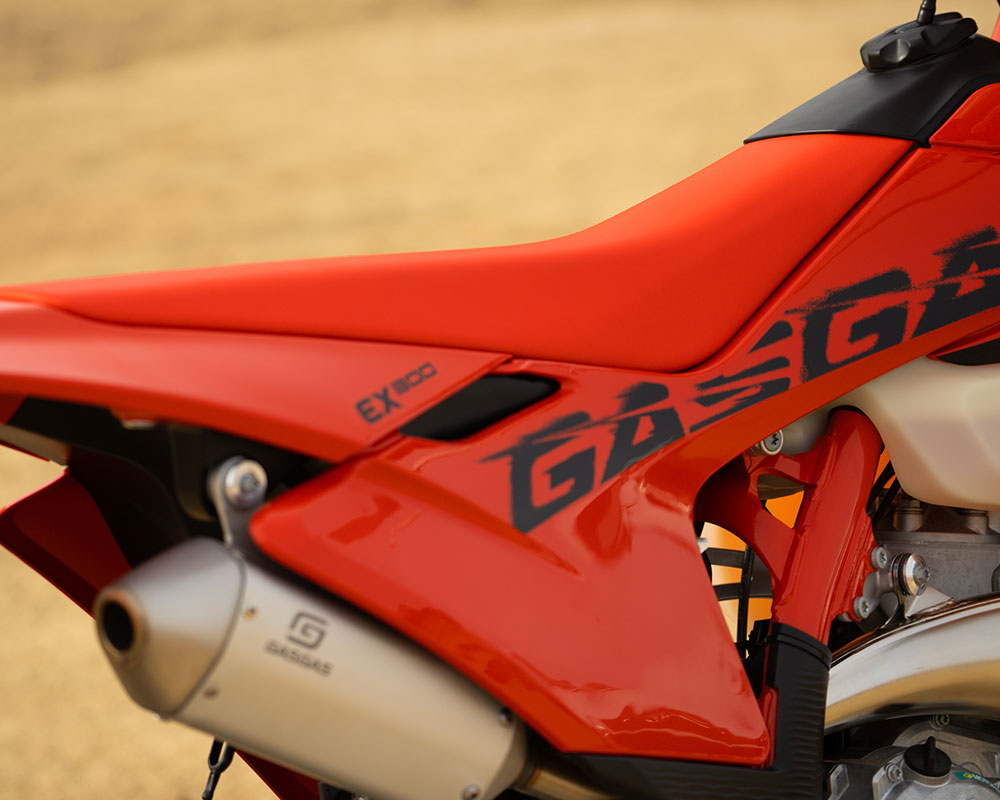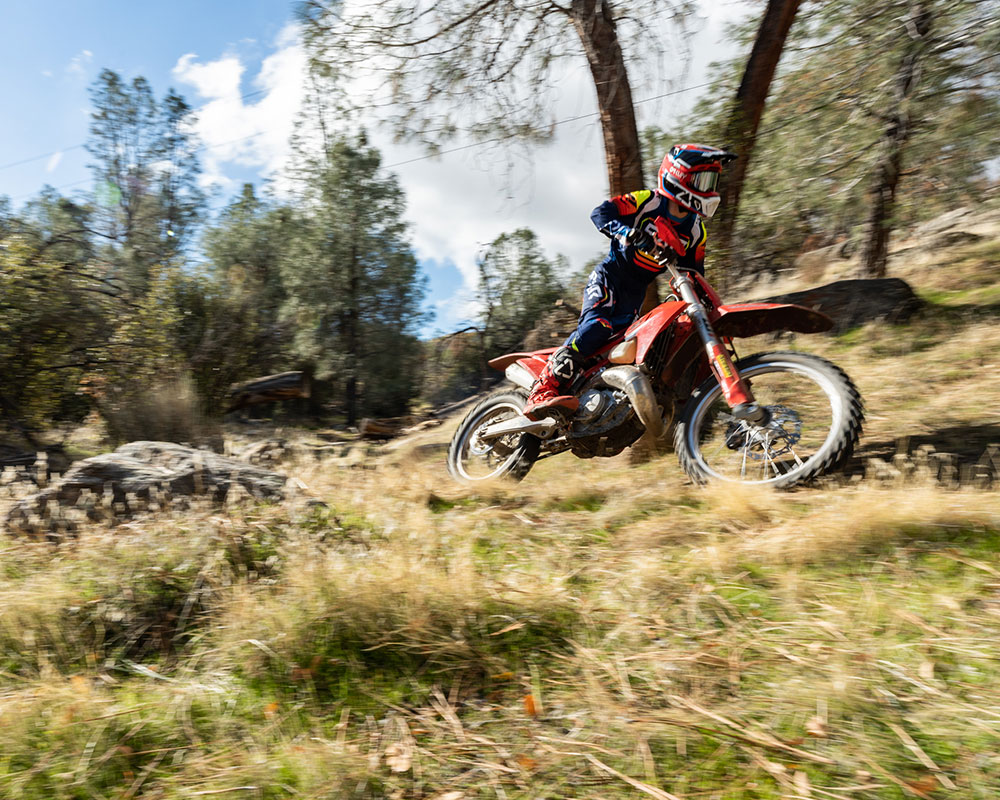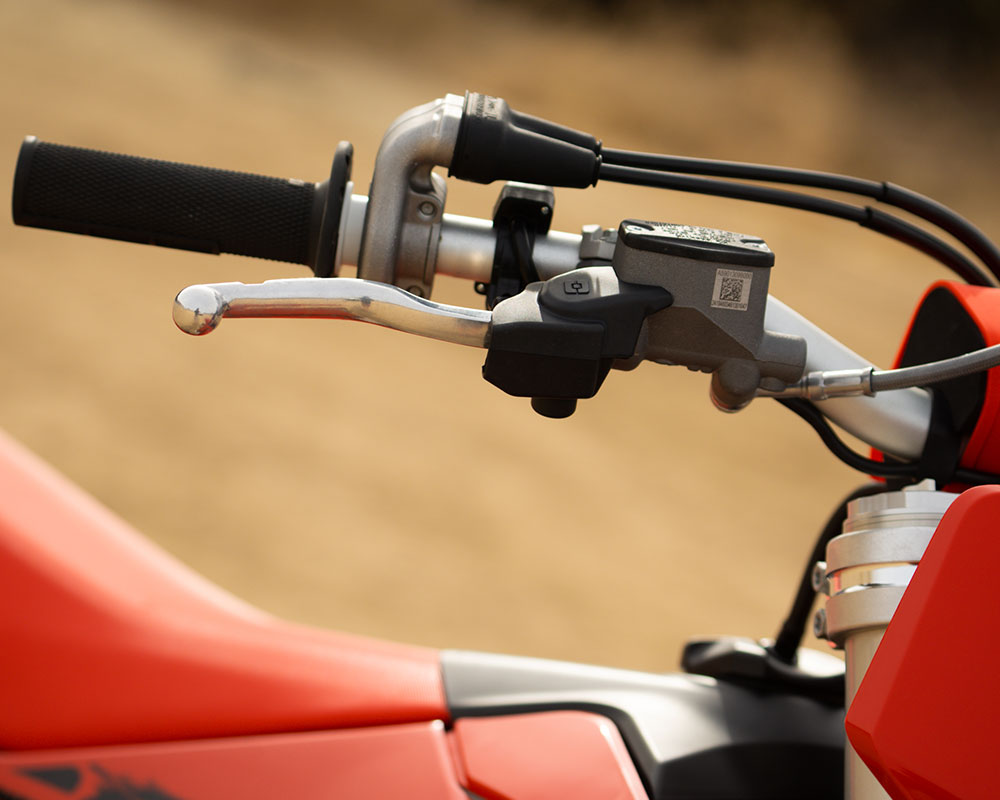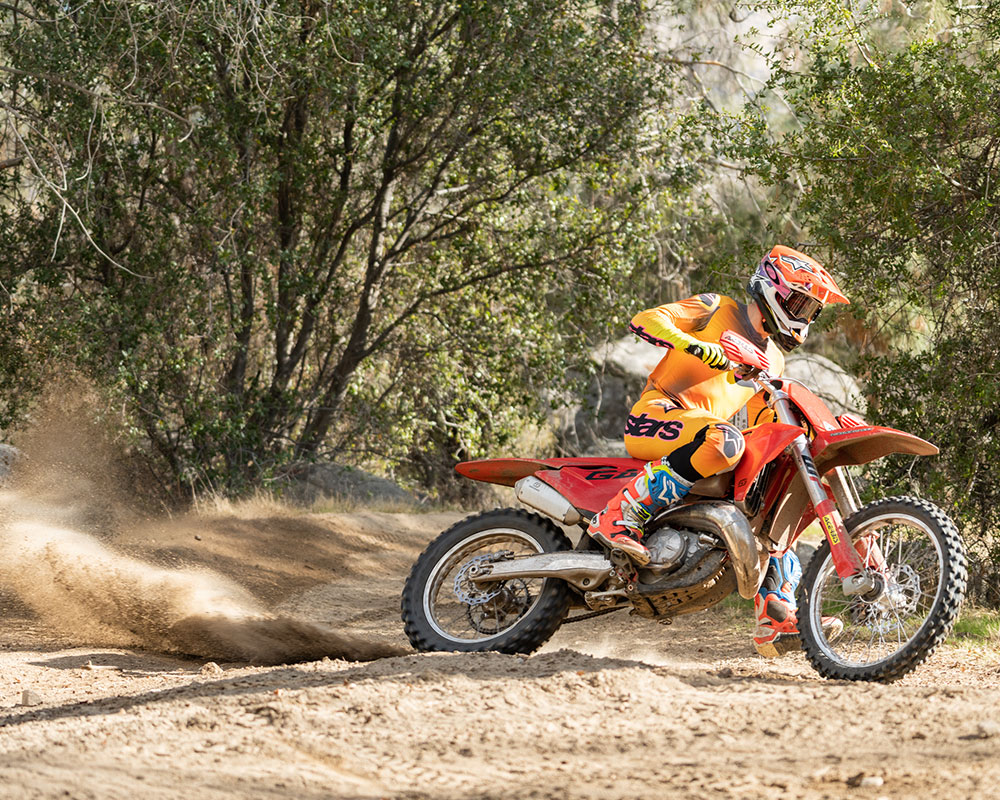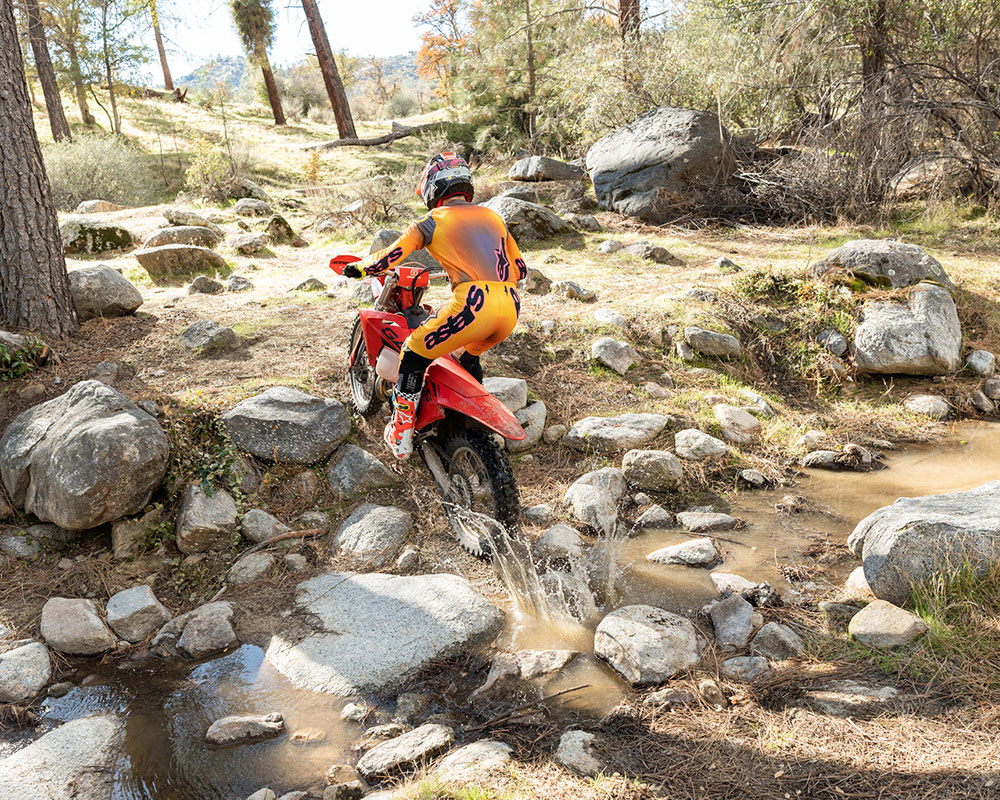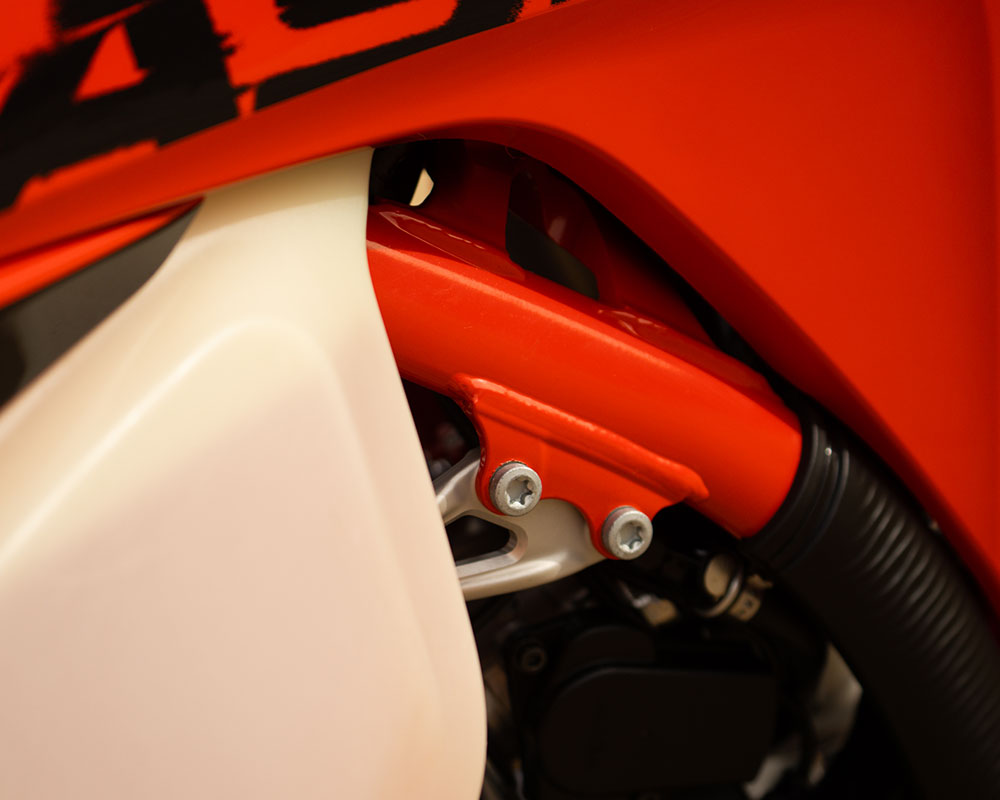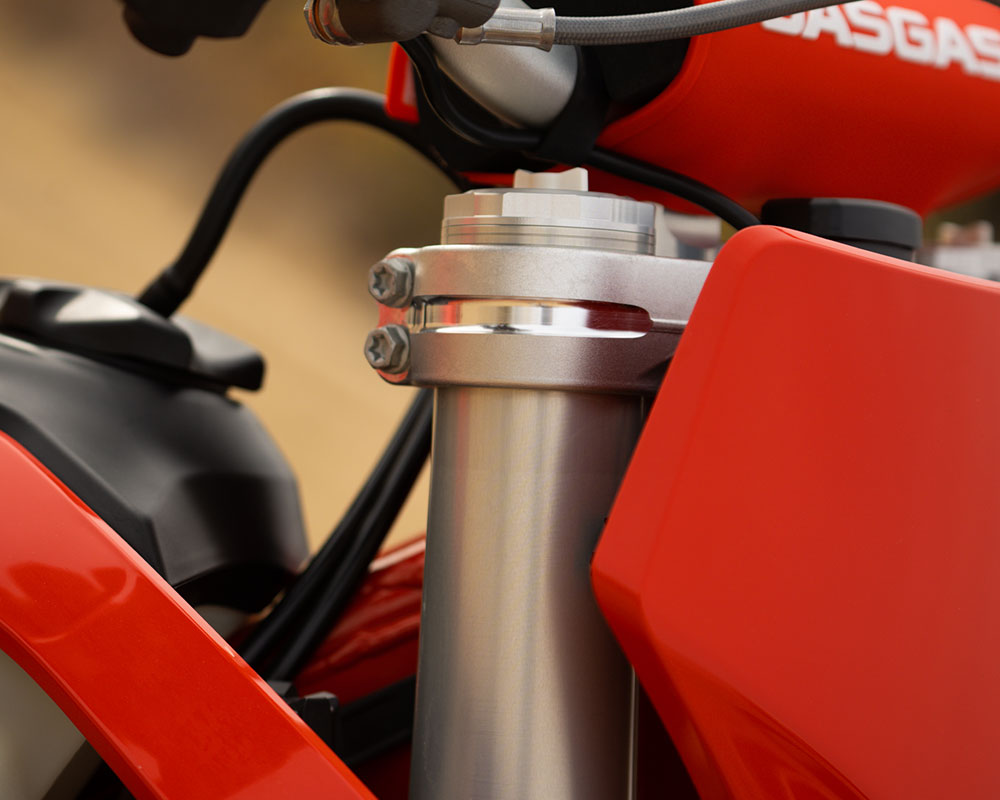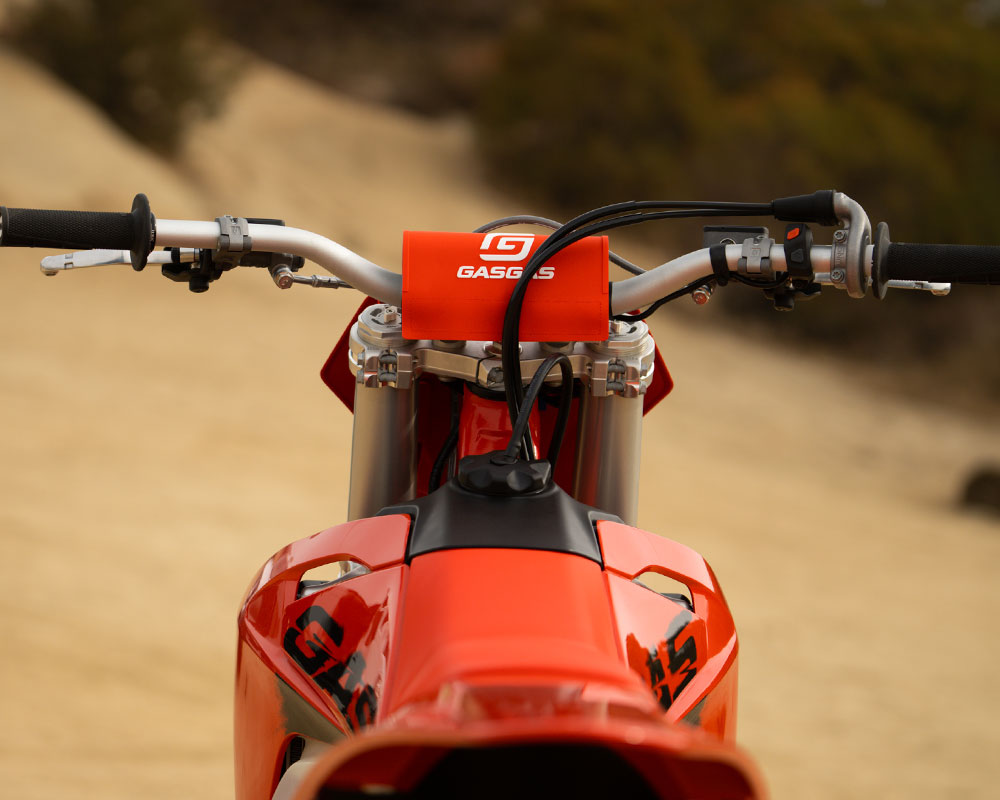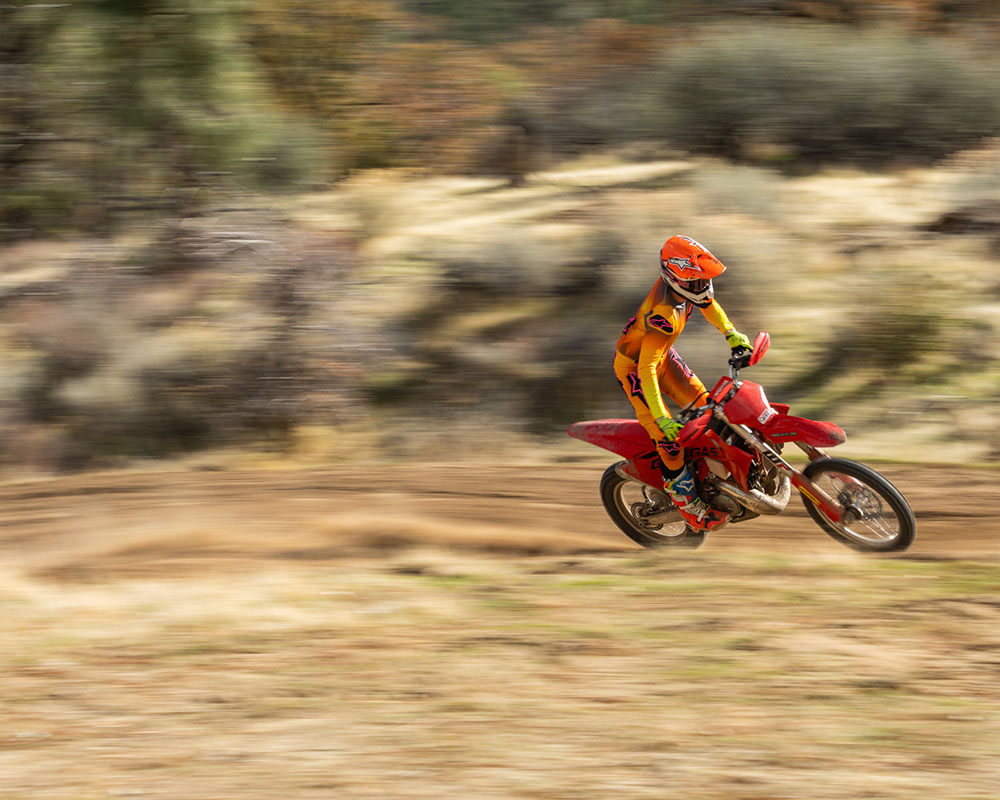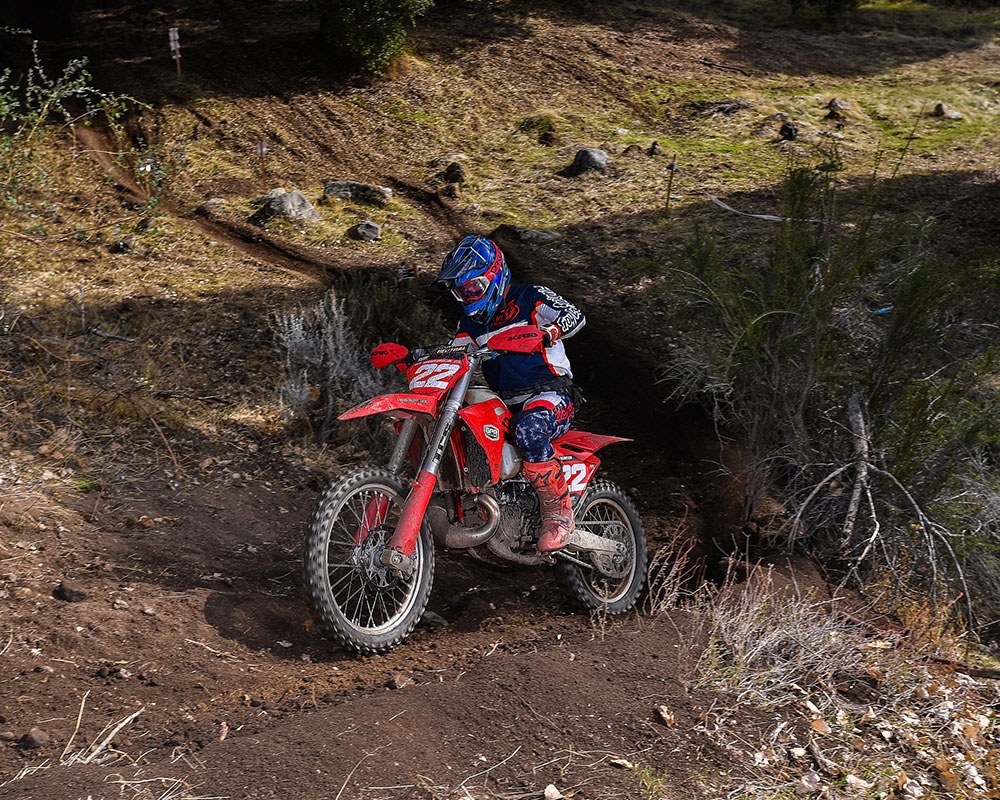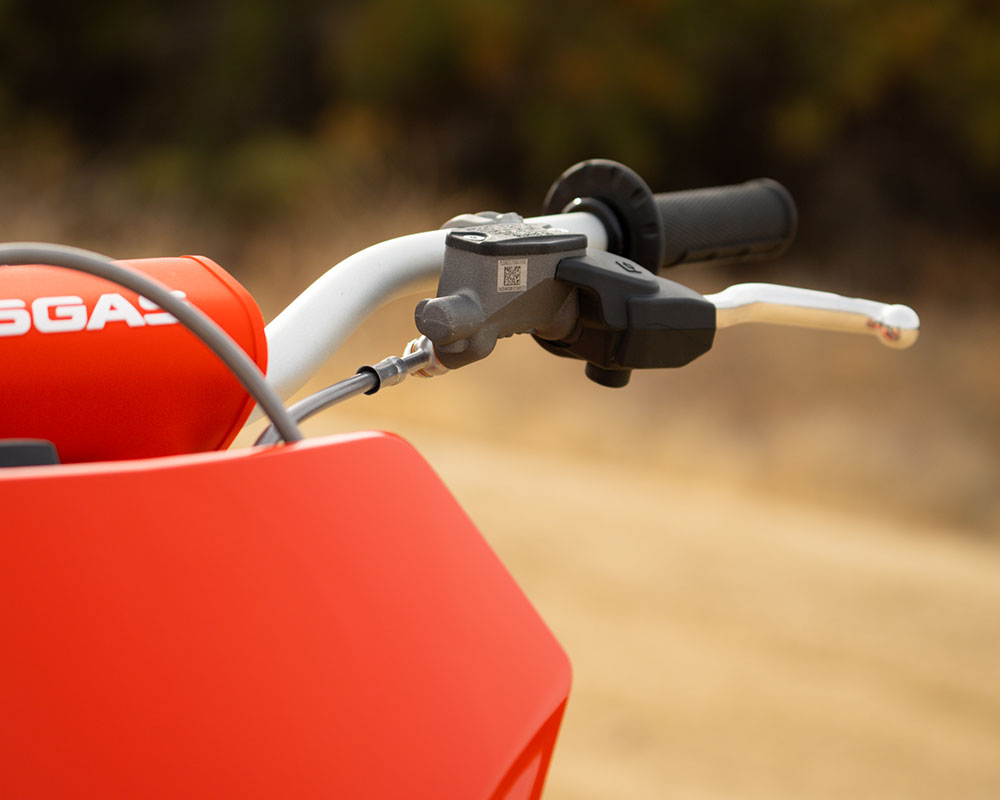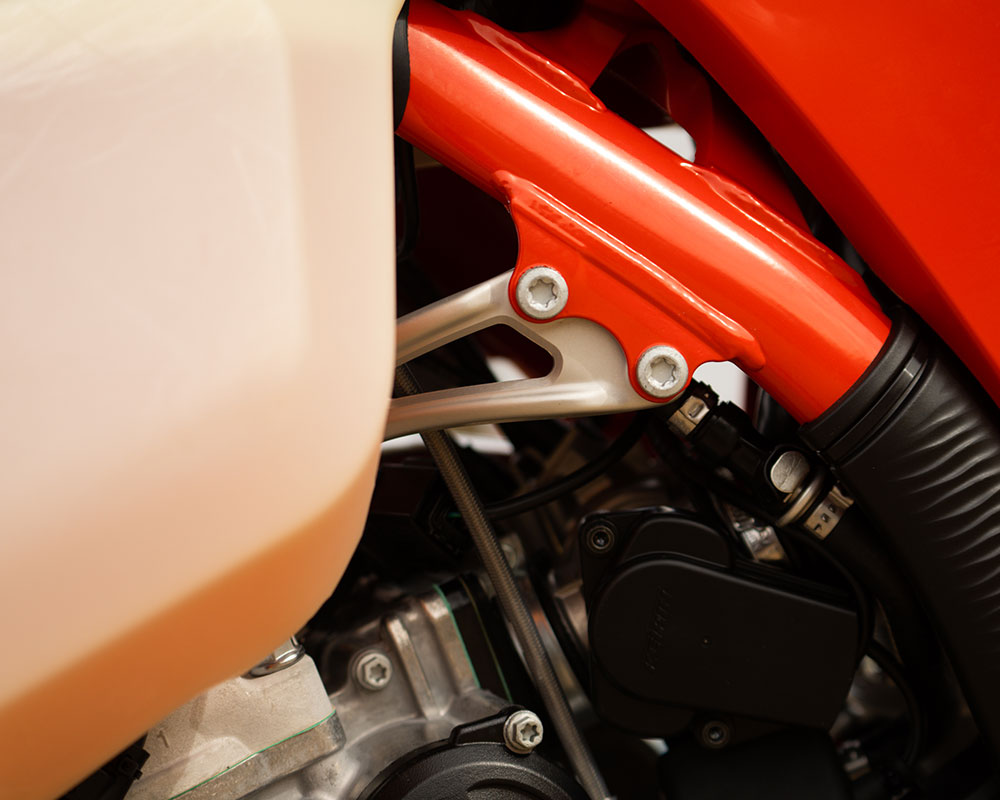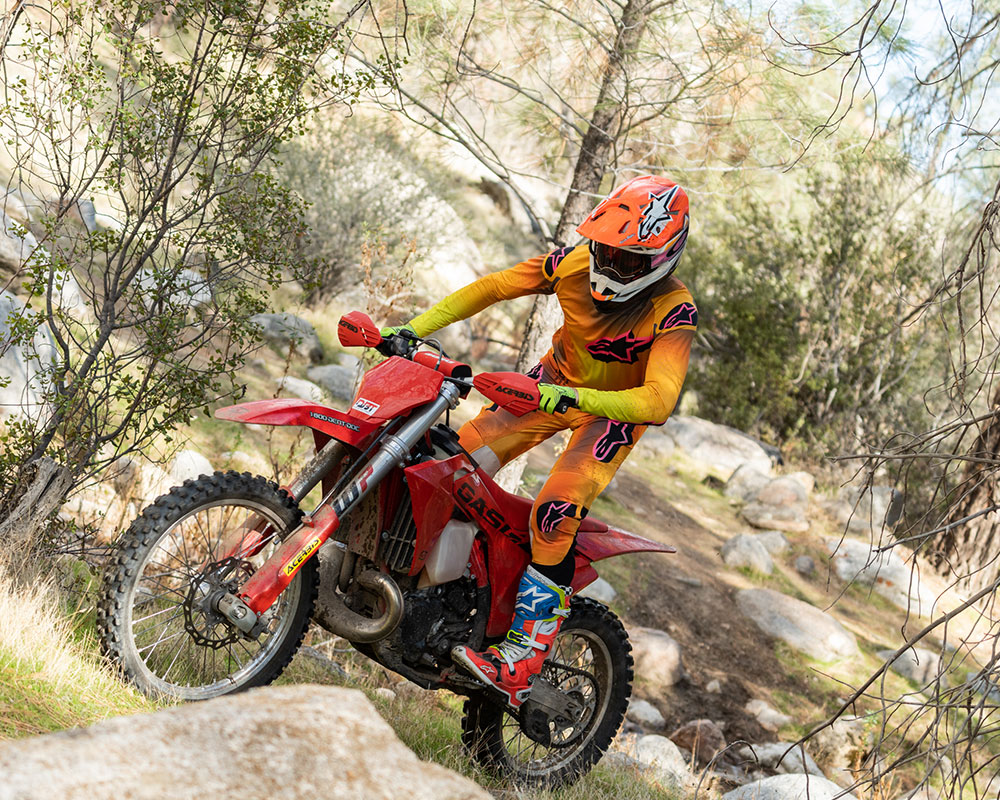2025 GasGas EX300
The All-Around All Star
MSRP: $10,749
- It's versatility shines in doing all disciplines.
- The power delivery offers something for everyone.
- Struggle with chassis balance due to shorter fork.
- Some of the components and design hinder the bike.
Introduction
- GasGas 300cc two-stroke off-road race model.
- Utilizes a TBi engine and a closed-cartidge spring fork.
GasGas is synonymous with off-road, particularly with a rich history in trials. When the KTM group purchased them a few years ago, they started using the same platform for their off-road bikes, and continue to to this day albeit with some cost effective differences spread throughout the bike, though sometimes for the better. The EX300 is the Spanish brand’s off-road race oriented 300cc two-stroke utilizing the newest Throttle Body Injected (TBi) engine, WP closed-cartridge spring forks, and the usual goodies that the KTM group outfits their off-road bikes with including an 18-in rear wheel, o-ring chain,a kickstand, off-road specific suspension settings, among other things.
Changes
- New frame, swingarm, and linkage designed to offer more flex and rider comfort.
- Updated suspension settings.
- New, stronger chain slider pad.
Changes are abundant and focused around the chassis for 2025. The frame has been refined with material removed around the shock tower and steering stem, complemented by new engine mounts. These changes are designed to increase the frame's flex characteristics to result in a more planted feel and increased comfort for the rider. The WP XACT rear shock also sees changes with new, lower friction seals in the linkage and a smaller diameter linkage bolt, contributing to smoother performance with more flex and better comfort in the rear end. Furthermore, a stronger chain slider on the updated swingarm improves durability, and a more robust rear brake pedal enhances resilience. Finally, the bike sports all-new graphics to cap it all off.
Some of the key differences between the GasGas and the KTM/Husqvarna models include Braktec brakes/clutch, forged aluminum triple clamps, no mapping switch, skid plate, or handguards, and of course the bodywork and styling.
Power
- Blends the best two-stroke and four-stroke characteristics into one package.
- Electronic power valve is tuned conservatively but has a lot of potential.
- Wide range from low RPM lugability to rev happy top end.
The motor on this bike is its shining star. We’ve had a number of different testers across a range of sizes and abilities ride it and all unanimously praise the 300cc throttle body injected engine on this bike. It takes some of the best characteristics from a four-stroke while retaining a lot of the classic two-stroke characteristics and combines it into one engine. The engine has torque. It has a little bit of a hit to it. You can lug it or you can rev it. It really has something for everyone and is easy enough to ride yet still aggressive enough to be fun and exciting. Like most bigger bore two-strokes, it makes most of its power in the bottom-mid range, though it does revs better than some other 300's we've tested in the past. We do feel tuning the electronic powervalve and playing with some mapping, we could get more power out of both ends of this bike, although do we really need it?
The engine has a lighter flywheel weight feel throughout most of the range and becoming increasingly lighter feeling as the PRMs build which helps the bike feel light and agile. This all helps that more exciting power delivery and increases the fun factor when riding this bike, something the former TPi engines lacked greatly but we feel is in a great spot on this XC engine platform.
The 6-speed transmission is a nice touch on this bike. First gear is low enough for pretty tough terrain with a little clutch work. Second gear is also very usable, but third gear is the magic gear on this bike. The engine has the torque to pull it at low RPMs in corners or trails, and it has enough pull through the mid range and into the top end to carry it seemingly forever. As we’ve come to expect on these FI Austrian two-strokes, the ability to lug and chug on this bike is second to none, yet the XC version still has that hit and more exponential power delivery curve that brings excitement and feels like a two-stroke. For a two-stroke, we found ourselves riding it much more like a four-stroke and not having to run through the gears nearly as much as we would on most other smokers.
One thing we did was mess with gearing on the bike. Stock is 14/48 and while it’s good, we felt we could tighten up the spacing between the gears a tad. Racing a hare and hound here in Southern California, we felt the bike went faster than we really wanted to go across valleys, aside from the start and any long dry-lake bed sections, yet we had to rev the bike out more than we wanted to when it got deep. Going to 14/49 if it's faster terrain or 14/50-52 nearly everywhere else, we found ourselves less in between gears and could ride the bike in the meat of the power more efficiently and effectively. This also makes second and third gear that much more usable in tighter trails and we didn’t really sacrifice much on top end since the sixth gear spreads far enough.
We have ~35 hours on this bike with very little maintenance required. We change the oil every 5-6 hours and keep the air filter clean. We feel the clutch is on the verge of needing to be freshened up, though we have quite a few hours playing in rocks and extreme enduro trails that was certainly hard on the clutch. One thing we did have to do was recalibrate the TPS. The Austrian brands say it doesn’t need to be done unless the top-end is pulled apart or the power valve is messed with, but ours did need to be calibrated even without touching anything. We know a few people who do it every 15-20 hours just to ensure it’s correct, and it only takes a couple of minutes so it doesn’t hurt to turn into a routine maintenance item every 15-20 hours. When you buy a bike, it should come with the plug used to adjust it, and you can watch THIS to learn more about the process of adjusting it.
We’ve been running 91 pump gas mixed at 50:1 using both Motorex and Maxima injector specific premix with zero issues. We’ve had other testers with the newer TBi two-strokes suffer from some pinging while using regular pre-mix without mixing race gas 50/50, but we’ve had no problems with straight pump gas and using injector specific pre-mix on this bike, including racing across a several mile long dry-lake bed at top speed in the cold of winter.
Vibration is nearly nonexistent on this machine. Surprisingly for a two-stroke, we’d even go as far to say it vibrates less than some modern four-strokes. The location of the fuel pump on these new bikes is not great. Because it sits up so high, if you’re trail riding down a smooth road without the gas sloshing around, it stops picking up the fuel and will “run out” of fuel even though it has fuel in the tank. The Braktec hydraulic clutch works well and is effective. It has good modulation, and a quick hit to the clutch helps bring this engine to life when needed.
If there’s one thing we wish we could do to this bike, it’s that we’d like to be able to adjust the power valve more with an app or tuner like Yamaha and now Kawasaki have. We’ve experimented with some different ECUs and tuning options and we know how big of a difference it can make which shows just how much potential is in this motor even though GasGas is being conservative with their tuning.
Suspension
- Quality suspension components that are easy and simple to dial in.
- 10mm shorter fork affects chassis balance.
- GNCC inspired setup that's safe yet performance oriented.
Over the years, some consumers and media outlets have pointed to the Austrian brands “weakest” point being their suspension. While air forks, particularly in off-road riding and racing, have a complicated relationship with the riders, there are a lot of good features to them and some of our riders actually prefer them over anything else. In 2024, the KTM group started equipping the off-road race models with a closed-cartridge spring fork on the front end of their motorcycles. We’ve put in quite a bit of time on this new fork across several models the last two years and we have a lot of positive takeaways including this fork.
The quality of the components and the tuning capabilities of this fork are about as good as any. The spring fork offers a consistent feel throughout the stroke and throughout the day, and the adjusters are very effective in dialing in the performance of the fork. The hand adjusters on both the fork and shock are welcomed and make clicker tuning a breeze trailside.
Both ends of the suspension feel well balanced and worked in unison together out on the trail. Front and back, both have good hold up initially and feel sporty, but as they get deeper into the stroke, they lack some hold up for bigger hits. In small chop and square edges, there is a little bit of an edge to it and you feel it slightly in your hands. But overall, there’s a lot of movement through the stroke and the suspension feels active, but not overly active and it transmits very minimal harsh feedback to the rider.
For suspension targeted towards east coast riding and racing, it’s set up very well for that environment and can be raced as is with little to no tuning. For a west coast bike, it could use some added bottoming resistance and some added comfort in the small chop, but we took it desert racing with just clickers adjusted and were very pleased with the performance and how hard we could push it. It’s soft for a Pro level racer, but it isn’t dangerous and we didn’t feel we were being held back much when racing across the desert valleys at 70-80mph.
If there was one thing that we would like to see changed, and this is more of a west coast off-road inspired change than anything, is a longer fork. This spring fork is 10mm shorter than the air fork and we struggle to find a good balance in the bike at times with this. The front end will feel low and something we chase in faster or rougher terrain. Some of our testers have dropped the forks to flush in the clamps, or even slightly below flush, to get the front end up and increase stability, but some of our riders feel that negatively affects front end grip and cornering too much when dropping below the 2nd line on the fork (which is stock height). When riding in single track and mountainous terrain, we had no issues with the fork height and felt the chassis balance was very good, which is realistically where GasGas targets their setup for with this bike.
One thing that we’ve found can help is shortening the rear shock 1-3mm internally. We’ve found that by doing this, we can reduce the sag number from 107-108mm to the 100-105mm range and get a more balanced feel out of the bike with the whole bike feeling slightly lower, similar to the new Yamaha FX models.
Chassis - Handling
- Improved rider comfort and stability.
- Very planted on the trail.
- Bodywork and layout of the bike can be tougher to work on.
The GasGas chassis underwent a major overhaul in 2023 and it came with a lot of criticism from the media and consumers. While we did experience a rigid feeling chassis on the four-strokes, we haven’t had as much of an issue with the two-strokes. A lot of that comes with the weight and inertia and power delivery of the motor, but it was far less of a problem on the smokers with the first gen chassis. However, this new chassis feels very solid and we haven’t struggled with comfort. Some of our testers have said this newest generation frame is their favorite from the Austrian group, two or four-stroke.
In comparison to last year's frame, we feel less feedback through the front of the bike as well as less through the footpegs which is an improvement in our eyes. For a two-stroke, it feels very planted and like it has weight behind it when needed, yet still playful and agile as you’d expect from a two-stroke. The balance between stability and planted feel vs agility is confidence inspiring and offers a good mix of both for a two-stroke.
The overall cockpit and rider ergonomics are pretty standard and what you’d expect from an Austrian bike with a flatter seat and the footpegs in a neutral position. The forged clamps that GasGas uses don't have different holes for the bar mounts, but we felt comfortable running the bar mounts in the stock position.
The Braktec brakes on this bike are good. For the most part, they have a firmer feel at the lever/pedal than the Brembos, but they are more touchy and less linear in power. Additionally, we have experienced them fading quicker than we’ve come to expect with Brembo units, especially the rear when it gets ridden hard.
The footpegs are durable and offer a lot of grip that doesn’t wear out as quickly as others. The Dunlop MX33F front tire is a nice touch on this bike, offering good bump absorption and traction over the standard AT81F front tire. The AT81 rear tire is decent, but there are better options from both Dunlop and other vendors when you wear out the tire.
In working on and living with this bike, it has become harder in some ways. A lot of the design and fitment of things is very clean and sleek, but it makes it harder to remove and work around. With time, we’ll learn all the little tricks and tips as we would with any bike, but we feel this bike has taken a small step back in ease of use when working on it. Also, the GasGas platform has different bodywork and a different design than that of the KTM and Husqvarna, and with that it becomes slightly more difficult to do the everyday stuff. For instance, the airbox cover is tied in with the radiator shroud and it’s more difficult to remove and install than the smaller cover that’s on the KTM and Husky, especially when an aftermarket tank is installed.
One thing to keep an eye out for is the seat bolt on the GasGas models. They’re prone to falling out and can result in you losing your seat mid race. The best thing to do is safety wire it so it cant fall out, but checking it before every ride should become the norm.
Conclusion
- A do-it-all machine.
- The complete package that is exciting yet rideable.
There’s something about a two-stroke that’s hard to resist. They’re fun to ride, relatively simple in design, and easy to rebuild. And the GasGas EX300 fits that bill (for the most part). Several of our testers have praised this bike, largely because of the engine and how fun yet easy it is to ride. If we could only have one bike in the garage to do it all, this would rank up near the top of the list. We can and have ridden and raced it in the desert, on the moto track, at a GP, and in the mountains and every time we get off of it, we have the biggest smile on our faces.
The power delivery has something for everyone and balances excitement and aggression with rideability, the suspension is of quality and race worthy out of the box, and the newest chassis is refined and more suitable for the masses. It’s hard to find a fault in the performance of this bike and the versatility proves that.
Recent Product Tests
Leave a Reply
